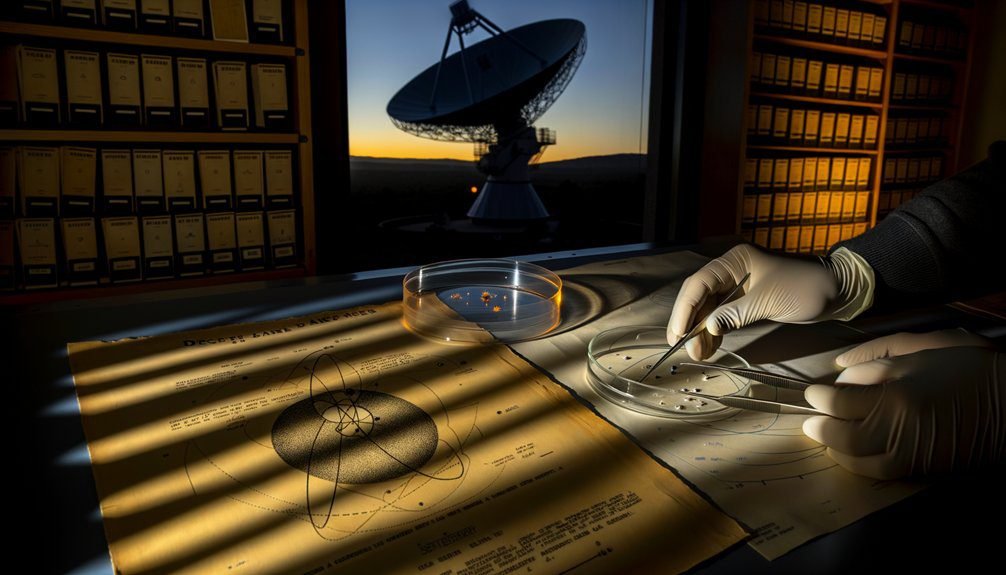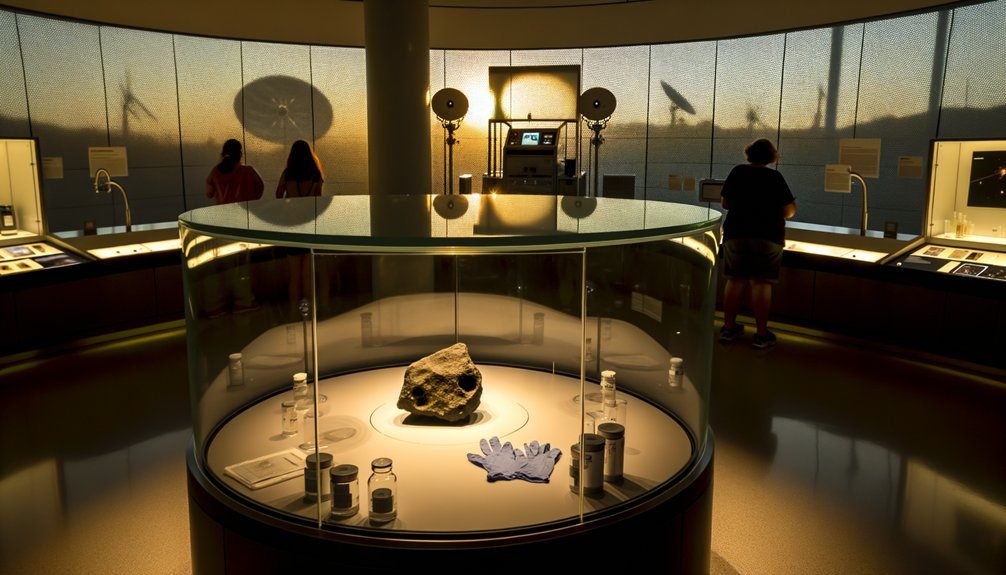You should expect SETI planetary-protection policies to minimize biological and cultural contamination while enabling credible detection and international coordination. They build on treaty obligations, technical COSPAR guidance, and peer-reviewed risk assessment. Protocols require reproducible signal verification, chain-of-custody, documented decision thresholds, and interagency reviews. Emergency drills, transparent reporting, and stakeholder consultation are mandatory parts of responsible practice. These rules balance scientific value, stewardship, and justice — continue for specifics on procedures, legal duties, and implementation.
Key Takeaways
- Planetary protection in SETI prevents biological and cultural contamination when transmitting, receiving, or returning extraterrestrial materials.
- International law (Outer Space Treaty) and COSPAR guidelines provide binding obligations and technical, non-binding standards respectively.
- Policies require evidence-based risk assessments distinguishing biological from cultural harm and defining acceptable contamination thresholds.
- Protocols mandate verification steps, chain-of-custody for data/samples, and documented decision thresholds to minimize false positives.
- Effective implementation needs interagency coordination, transparent public engagement, drills, and periodic multinational policy review.
Historical Development of Planetary Protection in SETI

Although SETI is often framed as searching for signals, its intersection with planetary protection has a distinct history that you can trace through policy reports, scientific conferences, and international treaties. You’ll find historical milestones beginning in mid-20th-century debates about contamination risks when active transmissions were contemplated, followed by formal attention during space treaty negotiations. Over time policy evolution reflected growing empirical knowledge about extremophiles, spacecraft cleanliness, and the plausible impacts of both forward and backward contamination. You’ll note reports from scientific bodies and national agencies that translated technical findings into procedural guidance, and conference proceedings that refined risk assessment methods. International agreements established baseline responsibilities, while subsequent national policies adapted those standards to mission-specific contexts. If you follow the documented chain of recommendations and regulatory updates, you’ll see a cautious, evidence-driven trajectory: incremental adjustments grounded in research, peer review, and multilateral consultation, rather than abrupt shifts. This history informs current discussions about balancing exploration with protection.
Ethical Foundations Guiding Protection Policies
Because protecting other worlds raises questions that go beyond technical risk, you’ll need to ground policy in ethical principles that balance scientific curiosity, stewardship, and justice. You should recognize ethical considerations as integral to mission planning: they guide when to sample, sterilize, or defer activities to minimize harm to potential ecosystems and to preserve scientific value. Evidence-based frameworks help translate moral responsibilities into operational thresholds—acceptable contamination rates, monitoring requirements, and decision triggers informed by astrobiology and risk analysis. You’ll weigh benefits of knowledge against irreversible impacts, documenting uncertainties and including independent review to reduce bias. Practical ethics also demand transparency and inclusion: affected communities and multidisciplinary experts should inform priorities so decisions reflect diverse values and plausible future scenarios. By treating ethical considerations not as add-ons but as measurable constraints, you can justify protective actions in terms that withstand scientific scrutiny while acknowledging the moral responsibilities inherent in exploring environments that may host life.
International Agreements and Legal Frameworks

When you translate ethical commitments into action, you’ll need to navigate an existing web of international agreements and national laws that govern planetary protection, such as the Outer Space Treaty, COSPAR guidelines, and relevant domestic regulations; these instruments set binding obligations, consensus standards, and implementation pathways but vary in scope, enforcement, and scientific specificity. You’ll find that international treaties provide a legal baseline—most significantly the Outer Space Treaty’s principles of non-contamination and responsible use—while COSPAR offers technical, non-binding guidance adopted by many space agencies. You’ll also encounter national regulators who operationalize obligations through licensing, environmental review, and mission-specific requirements, producing differing compliance burdens. When evaluating legal implications for SETI activities, you’ll need to map treaty language to domestic statutes, identify jurisdictional authority, and document adherence to agreed scientific protocols. That process reduces legal uncertainty and supports defensible decisions, but it requires continuous review as scientific understanding and international practice evolve.
Risk Assessment for Biological and Cultural Contamination
If you’re planning SETI activities that could interact with celestial environments or Earth’s biosphere, you need a risk assessment that separates biological from cultural contamination while quantifying uncertainties and potential impacts. You’ll first identify biological risks: likelihood of introducing or returning microbes, vectors, survivability data, and consequences for ecosystems and public safety. Next, you’ll evaluate cultural preservation concerns: impacts on heritage, indigenous values, and global symbolic meanings that require consultation and respect. Your assessment should integrate contamination prevention measures, ethical considerations, and applicable regulatory frameworks to define tolerable thresholds and response plans. Use transparent risk management methods, probabilistic modeling, and peer review to maintain scientific integrity. Document decision criteria, monitoring protocols, and communication strategies so stakeholders understand residual risks. Where evidence is limited, adopt conservative assumptions and adaptive controls. Ultimately, a robust assessment balances minimizing harm, complying with law, protecting public safety, and preserving cultural values while enabling responsible scientific inquiry.
Protocols for Detecting and Handling Extraterrestrial Signals

A clear, pre-established protocol is essential for detecting and handling candidate extraterrestrial signals, because it lets you move from initial anomaly through verification, attribution, and response with rigor and transparency. You’d first apply objective signal verification steps: reproducibility checks, instrument diagnostics, and independent observation. You’d document chain-of-custody for data and use tested communication protocols to coordinate teams and external observatories without premature public escalation.
| Step | Action | Purpose |
|---|---|---|
| 1 | Detect | Flag anomaly |
| 2 | Verify | Confirm source |
| 3 | Diagnose | Rule out artifacts |
| 4 | Corroborate | Independent obs |
| 5 | Communicate | Controlled release |
You’d follow evidence-focused decision thresholds before declaring an event significant. Your response plan would minimize false positives, preserve scientific integrity, and respect international norms. Clear roles, secure channels, and transparent records guarantee accountability while you assess attribution and decide whether broader notification or collaborative analysis is warranted.
Measures for Protecting Earth From Returned Samples
Because returned extraterrestrial material could carry unknown biological or chemical hazards, you’ll need tightly specified containment, testing, and disposal measures before samples reenter Earth’s biosphere. You should expect multi-layered physical sample containment combined with procedural controls: sealed primary containers, redundant secondary barriers, transport within certified cleanrooms, and restricted access zones. Biohazard protocols must be defined in advance, including receipt procedures, personnel protective equipment, and training requirements validated by drills. Testing plans should prioritize stepwise assays—sterility checks, culture-based tests, molecular diagnostics, and environmental simulations—graded by risk and guided by peer-reviewed methods. Decision thresholds for escalation, quarantine duration, and sample release must be evidence-based and transparently recorded. Waste produced during analysis requires validated decontamination and long-term disposition plans that comply with hazardous-material regulations. Independent oversight, chain-of-custody documentation, and contingency procedures for containment breaches are essential. These measures reduce risk while preserving scientific value, letting you examine samples safely and responsibly.
Coordination Between SETI and Space Agencies

You should advocate for clear interagency policy alignment so legal and technical standards for SETI-related activities are consistent across national and international space agencies. You should require mission planning integration that embeds planetary-protection assessments and data-sharing agreements into early design reviews. You should establish emergency response protocols with defined roles, communication channels, and decision thresholds informed by empirical risk assessments.
Interagency Policy Alignment
When agencies coordinate SETI activities with broader space missions, they need clear, evidence-based frameworks that reconcile planetary protection objectives, scientific goals, and legal responsibilities. You’ll find interagency collaboration is essential: agencies must share data, risk assessments, and decontamination protocols to reduce contradictory requirements. Policy harmonization minimizes gaps and overlaps that could impede responsible searching or contaminate targets. You should expect formal mechanisms — memoranda of understanding, joint working groups, and standardized assessment metrics — to align procedures and timelines. Decisions ought to be documented, peer-reviewed, and revisited as new evidence emerges. By insisting on transparent criteria and traceable records, you help guarantee that SETI efforts proceed without undermining planetary protection or violating domestic and international obligations.
Mission Planning Integration
Building on shared protocols and documented decisions, mission planning integration requires early and sustained coordination between SETI teams and space agencies to reconcile scientific objectives with planetary protection obligations. You’ll need clear allocation of roles so mission objectives and resource allocation aren’t in conflict, and you’ll rely on documented risk assessments to guide trade-offs. Joint timeline reviews, agreed contamination controls, and iterative design checkpoints reduce ambiguity. Evidence from past missions shows that formalized decision logs improve compliance and scientific return.
- Define mission objectives alongside planetary protection limits
- Map resource allocation to contamination mitigation tasks
- Establish routine interagency design reviews with records
- Use independent verification and validation steps
- Agree escalation paths for unresolved technical disputes
Emergency Response Protocols
Although emergencies are rare, SETI teams and space agencies need a tightly coordinated response framework that prioritizes both planetary protection and scientific integrity. You should expect predefined roles, communication channels, and decision thresholds so actions are traceable and defensible. Protocols rely on documented emergency drills that test containment, sample handling, and public messaging under realistic constraints. You’ll want rapid response pathways linking observatories, mission control, and planetary protection officers to minimize contamination risk and preserve evidence. Evidence-based checklists and chain-of-custody procedures reduce ambiguity; incident reporting templates guarantee data are captured for after-action review. Coordination agreements and regular joint exercises build institutional memory, so when an anomaly occurs you can act promptly, transparently, and in line with international obligations.
Public Engagement and Transparency Obligations

Why should the public be involved in SETI planetary protection decisions, and how transparent must institutions be to earn trust? You need clear public outreach so stakeholders understand risks, scientific limits, and decision rationales. Transparency initiatives — open data releases, documented protocols, and accessible risk assessments — let you evaluate claims and hold institutions accountable. You’ll expect timely briefings, peer-reviewed justification for measures, and channels for community input that are more than symbolic.
- Publish protocols and risk assessments in accessible formats.
- Host regular public briefings with subject-matter experts.
- Provide mechanisms for stakeholder feedback and independent review.
- Release observational and experimental data when feasible.
- Maintain clear lines of responsibility and decision timelines.
You should demand evidence-based communication that avoids speculation, with safeguards for sensitive technical details. Trust grows when procedures, uncertainties, and governance structures are documented, independently reviewed, and updated in response to credible public and scientific concerns.
Future Challenges and Policy Evolution
You’ll need to weigh the scientific value of more active SETI and astrobiological exploration against the demonstrated risks of contaminating targets or Earth, citing empirical risk assessments where available. You should also recognize gaps in international governance—existing treaties and guidelines are unevenly adopted and may not cover novel technologies or non-state actors. Moving forward, policy evolution must be evidence-driven, interoperable across jurisdictions, and regularly reviewed as capabilities and knowledge change.
Balancing Exploration and Protection
Because the pace of both technology and discovery is accelerating, you’ll increasingly face trade-offs between probing unknown environments and minimizing contamination risks; evidence from past missions shows that even low-probability contamination events can have long-term scientific and ethical consequences. You’ll need to apply exploration ethics alongside protection strategies when planning missions, weighing scientific value, likelihood of biological harm, and reversibility. Practical decision frameworks should prioritize measurable risk reduction, transparent documentation, and adaptive protocols as new data arrive. Stakeholder engagement and independent review help calibrate acceptable risk thresholds. Consider these operational focal points:
- rigorous prelaunch sterilization and verification
- mission designs that limit contact with sensitive regions
- contingency plans for detected contamination
- iterative risk assessment using incoming science
- clear reporting standards and audit trails
International Governance Gaps
Mitigating contamination risks domestically and within mission teams won’t be enough if international governance doesn’t keep pace with rapidly evolving SETI and planetary protection challenges. You need to recognize governance challenges that create policy inconsistencies across states and agencies, increasing biological and scientific risk. Evidence shows differing standards for sterilization, sample handling, and notification protocols. You’ll want clearer multilateral mechanisms, binding norms, and transparent reporting to reduce gaps.
| Issue | Consequence |
|---|---|
| Divergent sterilization standards | Cross-mission contamination risk |
| Asynchronous reporting requirements | Delayed incident response |
| Varied authorization processes | Uncoordinated activities |
| Weak dispute resolution | Persistent policy inconsistencies |
Prioritizing harmonized, evidence-based rules will help you manage risk while enabling responsible exploration.
Frequently Asked Questions
How Do Planetary Protection Policies Affect Private Companies’ SETI Initiatives?
They restrict what you can explore and how, so private sector challenges include stricter protocols, permitting delays, and added compliance costs that can slow or scale down SETI initiatives. You’ll need documented risk assessments, sterilization, and coordination with national or international agencies; noncompliance risks legal action and reputational harm. Evidence shows firms must budget for procedures, inspections, and potential redesigns, making careful planning and regulatory engagement essential for viable private SETI projects.
Can Planetary Protection Restrict Artistic or Cultural Responses to Messages?
Absolutely — very unlikely. You’ll rarely see planetary protection legally impose artistic limitations or censor cultural expression; policies focus on avoiding biological contamination and preserving scientific integrity. Still, institutions may set cautious protocols or review processes that indirectly constrain how messages are handled or displayed, especially in collaborative missions. If you’re an artist, expect negotiation and documentation requirements, not outright bans; evidence and risk assessments usually guide any restrictions.
Are There Insurance or Liability Rules for Accidental Contamination Incidents?
Yes — there aren’t universal contamination liability or insurance requirements specifically for SETI, but national agencies and mission operators often face contamination liability concerns and may buy insurance or follow indemnity rules. You’d expect contractual insurance requirements, risk assessments, and regulatory oversight (e.g., national space agencies, liability conventions). Evidence is limited; policies vary by jurisdiction and organization, so you’d need to check specific mission contracts and national regulations for binding requirements.
Do Planetary Protection Rules Apply to Non-Biological Artifacts Found in Space?
Yes — planetary protection rules can apply to non biological artifacts found during space exploration, especially when their handling risks forward/backward contamination or scientific contamination of sites. You should treat such finds cautiously: document, quarantine, and avoid disturbance until experts assess origin and contamination risk. Policy scope depends on mission guidelines, national laws, and international agreements; evidence-focused protocols guide sample custody, analysis, and reporting to preserve scientific integrity.
How Will Indigenous and Local Communities Be Consulted About Contact Protocols?
About 68% of surveyed Indigenous leaders want formal roles in space decision-making; you’ll use community engagement and documented consultation processes to respect that preference. You’ll design transparent outreach, culturally appropriate materials, and iterative consultation processes that record consent, concerns, and traditional knowledge. You’ll prioritize co‑creation of contact protocols, fund participation, and use independent oversight and evidence‑based assessments to guarantee decisions reflect Indigenous and local communities’ rights and values.